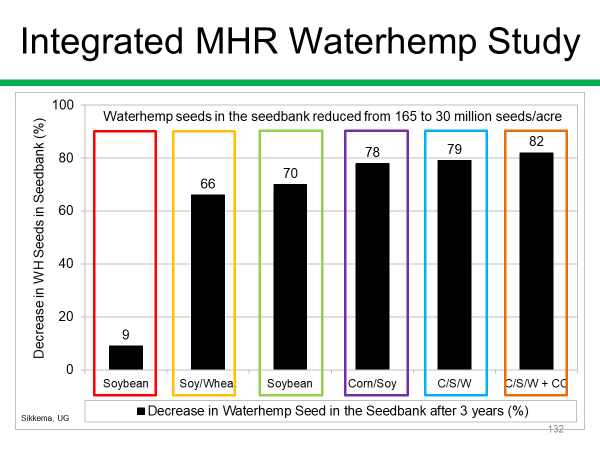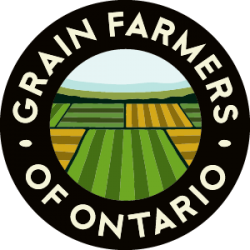Integrated Weed Management strategies for the control of glyphosate-resistant waterhemp
Principal Investigator: Peter Sikkema
Research Institution: University of Guelph
Timeline: May 2017 – April 2021
Objectives:
- To develop an Integrated Weed Management (IWM) strategy that will provide near perfect waterhemp control and deplete the number of waterhemp seeds in the soil seedbank by 95%.
Impacts:
- The study of long-term, sustainable weed management strategies may lead to the development of an Integrated Weed Management strategy that will provide excellent multiple-herbicide-resistant waterhemp control in corn, soybean, and wheat rotation and deplete the number of waterhemp seeds in the seedbank.
Scientific Summary:
The overreliance on a single weed management strategy or a simplified crop rotation may have short-term advantages such as simplicity and possible short-term profit maximization but may have long-term detrimental effects due to the evolution of herbicide-resistant weed biotypes. Herbicides have been a very cost-effective option for weed management in field crops for over 70 years. But the overreliance on herbicides has resulted in the evolution of herbicide-resistant biotypes, sometimes multiple-resistant biotypes as is the case with waterhemp (Amaranthus tuberculatus var. rudis) in Ontario. Studies conducted on commercial farms in Ontario found that waterhemp interference results in an average yield loss of 19% in corn and 43% in soybean. On commercial farms in Ontario with extremely high waterhemp pressure the yield loss can be up to 99% in corn and 93% in soybean. Glyphosate-resistant (GR) waterhemp has been confirmed in 15 Ontario counties from Essex county in the southwest adjacent to Michigan border to Glengarry county adjacent to the Quebec border. To make matters worse, 4-way resistance to Group 2 (Pursuit), Group 5 (Atrazine), Group 9 (Roundup) and Group 14 (Reflex) herbicides has been confirmed in eight counties, 3-way resistance in six counties and 2-way resistance on one county. This dramatically reduces the herbicide options for controlling this competitive weed. This small-seeded, summer annual, broadleaf weed has an extended emergence pattern, has high genetic diversity, is a prolific seed producer, is very competitive and has the potential to spread rapidly throughout Ontario if not properly controlled.
The project aimed to study many of the principles of IWM to deplete waterhemp seed in the seedbank and to develop a more sustainable approach to weed management using multiple weed management tactics. The diverse crop rotation included crops with different seeding and harvesting times, crops with different row widths, the inclusion of cover crops, and the use of multiple herbicide modes of action. These integrated strategies were expected to limit the selection of herbicide-resistant waterhemp and reduce waterhemp seed return to the seedbank. Waterhemp seed density in the seedbank was determined prior to initiating the experiment and after the 3rd year of the study (after one cycle of a 3-year crop rotation). Corn, soybean and wheat was grown in a 3-year rotation, with a cover crop seeded after winter wheat harvest. The most efficacious herbicides were used in each crop. As a result of this research Ontario grain farmers will now have data from local studies on the effectiveness of many of the principles of IWM that could lead to the development of long-term, sustainable weed management strategies for control of waterhemp in corn, soybean and wheat rotation.
At the Cottam site after three years, in the continuous soybean with Roundup, the two-crop rotation of soybean/wheat, continuous soybean with Fierce followed by Roundup Xtend, the two-crop rotation of corn/soybean, the three-crop rotation of corn/soybean/wheat and three-crop rotation of corn/soybean/wheat followed by a oat/tillage radish cover crop there was a decrease in the number of waterhemp seeds in the seedbank of 9, 66, 70, 78, 79 and 82%, respectively (Figure 1).

The results clearly demonstrate that growers with multiple-herbicide-resistant waterhemp on their farms can reduce the number of seeds in the seedbank by implementing an integrated waterhemp management program. The implementation of an integrated waterhemp management program on Ontario farms can possibly eliminate this weed species from a field in less than 10 years.
Waterhemp interference on Ontario farms reduced corn and soybean yield 19 and 43%, respectively. With the IWM programs developed, this crop yield loss can be eliminated which will result in dramatically higher net returns for Ontario farmers.
External Funding Partners:
BASF
Bayer Crop Science
Syngenta
Valent Canada

